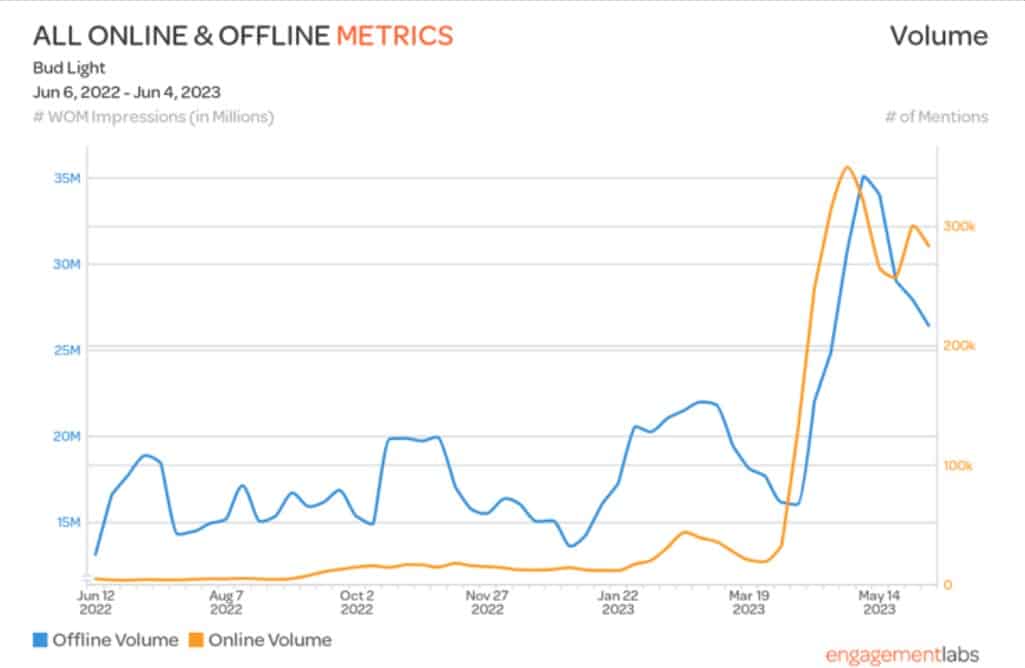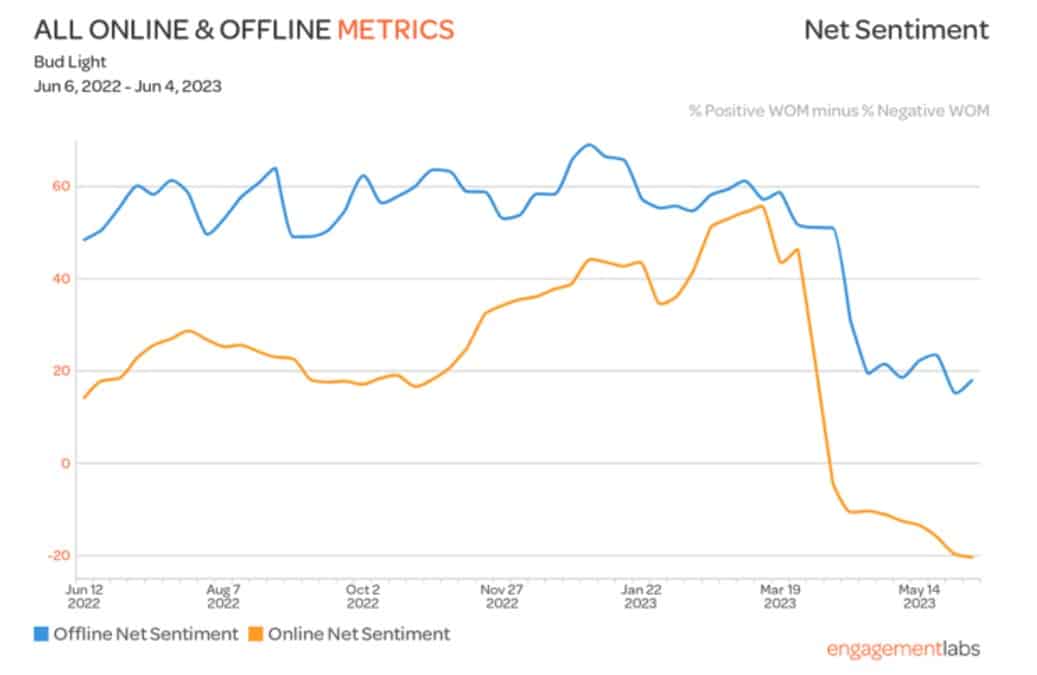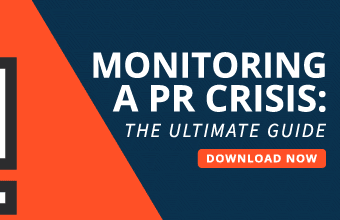Demographics Unmasked: How Male Consumers Shape Bud Light’s Narrative
In the realm of marketing and advertising, data-driven insights are paramount to success. When it comes to maximizing sales, brands, advertisers, and media, brands need to tap into the power of consumer conversations.
In this article, we delve into Bud Light’s TotalSocial data, exploring how offline and online conversation sentiment affects sales. By examining the controversy involving transgender influencer Dylan Mulvaney and its subsequent impact on sentiment, we shed light on the predictive power of offline conversations when sentiment takes a plunge.

There is no question, Bud Light’s business is suffering. FOX Business recently reported on losses not only affecting the Bud Light brand, but Anheuser-Busch’s brand sales overall. “For the week ending May 27, NielsenIQ data that Bump Williams Consulting provided to FOX Business showed that Bud Light posted a 23.9% decrease in sales on a dollar basis compared to a year ago. The Anheuser-Busch-owned brand’s sales have fallen 24.5% in the past four weeks ending with that one, according to the data.”
So how can keeping a finger on the pulse of Americans’ conversations have helped Anheuser-Busch better understand the fallout of the issue?
The Dylan Mulvaney Controversy
Bud Light is no stranger to embracing Pride Month, and up to this point enjoyed largely positive conversation sentiment, offline and online. In fact, Bud Light’s commitment to the movement earned the brand a top LGBTQ+ rating from the Human Rights Campaign Foundation last year.
However, all that changed in April. On April 1, Dylan Mulvaney, a prominent transgender influencer, posted a video on her Instagram, showcasing a Bud Light as a brand partner. This act, part of a series of corporate freebies she shares with her millions of followers, generated significant attention and backlash. Then, in a misstep by Anheuser-Busch, the company mishandled their response. Their response led to the company being stripped of the top LGBTQ+ rating given by the Human Rights Campaign Foundation. The crux of the situation is that Bud Light managed to anger customers while also not supporting Dylan Mulvaney, thus also managing to upset the consumers they were trying to target.
Conversation Sentiment Eroded
The consequence was immediate. Americans’ conversations about Bud Light erupted, not only on social media, but offline as well as measured by Engagement Labs TotalSocial. And unfortunately for Bud Light, it was not a spike in Americans saying good things about the brand. Instead social media became a hub for expressing concerns and criticism. Meanwhile, consumers’ everyday conversations about Bud Light – those conversations happening face-to-face in stores, backyards, homes turned largely negative following the incident as well.
Volume of Bud Light’s Offline and Online Conversations

Bud Light Offline and Online Net Sentiment (Positive Less Negative) Impact

What Does This Mean for Bud Light?
We have seen with other brand crises, that while brands will experience a dramatic lift in negative social buzz, offline conversations happening in-person and in the real world remain somewhat stable or unaffected. This happened in the case of Dick’s Sporting Goods following the announcement that they would stop selling assault rifles in response to the Parkland tragedy. Social media buzz immediately grew negative in tonality, while offline remained relatively stable. However, one year following the announcement, Dick’s Sporting Goods showed steady performance on business KPIs, which is much more in line with the steady sentiment seen among offline conversations.
Unfortunately, when there is a stark decline in both online and offline sentiment, as is the case with Bud Light, a different picture emerges with far greater implications for sales. Offline net sentiment, or positive less negative/mixed conversations, acts as a barometer for consumer sentiment. In the case of Bud Light, offline sentiment witnessed a sharp decline, which was largely driven by male consumers, the brand’s most active contributors to Bud Light’s word-of-mouth (WOM). This erosion in real life conversation sentiment served as a predictor of Bud Light’s loss in sales.
By contrasting Bud Light’s story with a brand like Dick’s Sporting Goods – which experienced a drop in online sentiment while offline sentiment remained stable – we uncover the pivotal role played by offline conversations.
Lessons for Brands in Crisis
During crises such as this, it is more important than ever for brands to keep a finger on the pulse of what consumers are saying in the real world. Looking at offline conversation data will help brands not only better predict the impact on business KPIs, but also help find ways to get out ahead of the crises. If Bud Light was able to fully understand the impact the incident was having on their core market early on, perhaps the company would have engaged with their audience differently — addressing their concerns, and finding ways to regain their trust.
During a brand crisis, it is important to:
- Keep a finger on the pulse of what consumers are saying about your brand, especially offline or in the real world. By understanding what people are saying at BBQs, in stores, at a friend’s house, and so on, marketers can better predict how sales will be impacted. Monitoring social buzz alone only gives marketers a small piece of the puzzle. Our research shows that when real-world conversations are tainted, this signals a much bigger problem for brands.
- Understand who is driving any changes in conversation. Once you know more about who is driving the negative change, it is important for marketers to find ways to engage those audiences.
- Monitor real-time social media buzz. While offline sentiment remains more representative and authentic, online sentiment experiences periodic fluctuations may signal something that requires your attention. Brands must invest in social listening to effectively monitor online conversations. Proactively addressing potential reputation risks can lead to a reduction in such risks.
By leveraging the data-driven insights such as those derived from TotalSocial, stakeholders can identify sentiment patterns, understand the demographic segments driving conversations, and implement targeted strategies to foster positive sentiment. This proactive approach helps mitigate potential declines in sales and ensures the brand remains in tune with consumer sentiment both offline and online.
This article originally appeared on the Engagement Labs blog; reprinted with permission.








